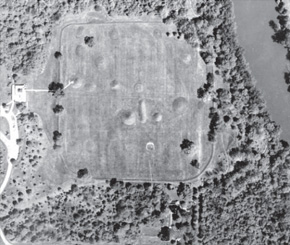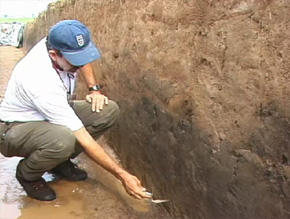MOUND CITY
HOPETON EARTHWORK

An aerial photo from 1938 shows the clear outlines of Hopeton’s circle andsquare, similar in size to Shriver Circle and Mound City, respectively.
Directly across the Scioto River from Mound City are the Hopeton earthworks: a large square, with a circle slightly
overlapping it. Two smaller circles mark gateways to the square in different ways; and long parallel walls lead to
the bank of an old channel of the river. The ancient walls once stood twelve feet high, but farmers have plowed, and
even bulldozed them, so only faint traces remain. Yet on old aerial photographs, or with new magnetic sensors, the
ancient lines still leap to life.
Dr. Mark Lynott explains his discoveries inside the wall at Hopeton, during the summer of 2002:
We’re near the center of the wall here, and this shows very clearly a section of how the wall is constructed. At the
base we have a yellow subsoil where the topsoil had been stripped off. And then the Hopewell came in and put this black
section of sterile clay in here. It has a little bit of burned material but no artifacts. And then above it they’ve
added this red, somewhat loamier, clay; and this is highly magnetic, and that’s what’s worked so well
with our magnetometers.
Dr. Lynott continues:
This is, in its own way, by the organization of the Hopewell people, as spectacular as the Mayan Pyramids, as the Egyptian
Pyramids, because these folks are not agricultural societies; they’re not organized that way. They’re much more of
an egalitarian group of people; they’re much more mobile, and yet they still managed to build some spectacular earthen
monuments here. And what’s incredible is that doesn’t fit with the traditional anthropological models of social organization
and accomplishments.
After the 1930s, mechanized agriculture rapidly accelerated the destruction of many of the giant geometric earthworks like
Hopeton. We can trace this process by comparing aerial photographs: In 1938, the walls still showed up clearly, even
the long parallels going down toward the river. But by 1985, though, nothing is visible. The walls have been flattened
to low, wide shapes, and are barely visible at all, from either the air or eye-level.



